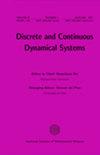三维系统的动力学特性与能量-卡西米尔映射图像之间的联系
IF 1.1
3区 数学
Q1 MATHEMATICS
引用次数: 0
摘要
研究了一类三维系统的动力学性质与能量-卡西米尔映射图像的几何特征之间的联系。通过研究这类系统的能量-卡西米尔映射,我们可以探讨平衡态的稳定性、周期解的分布以及同斜轨道或异斜轨道的存在性。我们应用我们的发现来研究两个特定方程的动态行为,并为这两个系统提供了能量-卡西米尔映射纤维的拓扑分类。本文章由计算机程序翻译,如有差异,请以英文原文为准。
The connection between the dynamical properties of 3D systems and the image of the energy-Casimir mapping
We investigate the connection between the dynamical properties of a class of 3D systems and the geometric characteristics of the image of the energy-Casimir mapping. By examining the energy-Casimir mapping for such systems, we can explore the stability of the equilibrium states, the distribution of the periodic solutions, and the existence of homoclinic or heteroclinic orbits. We apply our findings to investigate the dynamic behavior of two specific equations, and provide a topological classification of the fibers of the energy-Casimir mapping for the two systems.
求助全文
通过发布文献求助,成功后即可免费获取论文全文。
去求助
来源期刊
CiteScore
2.50
自引率
0.00%
发文量
175
审稿时长
6 months
期刊介绍:
DCDS, series A includes peer-reviewed original papers and invited expository papers on the theory and methods of analysis, differential equations and dynamical systems. This journal is committed to recording important new results in its field and maintains the highest standards of innovation and quality. To be published in this journal, an original paper must be correct, new, nontrivial and of interest to a substantial number of readers.

 求助内容:
求助内容: 应助结果提醒方式:
应助结果提醒方式:


